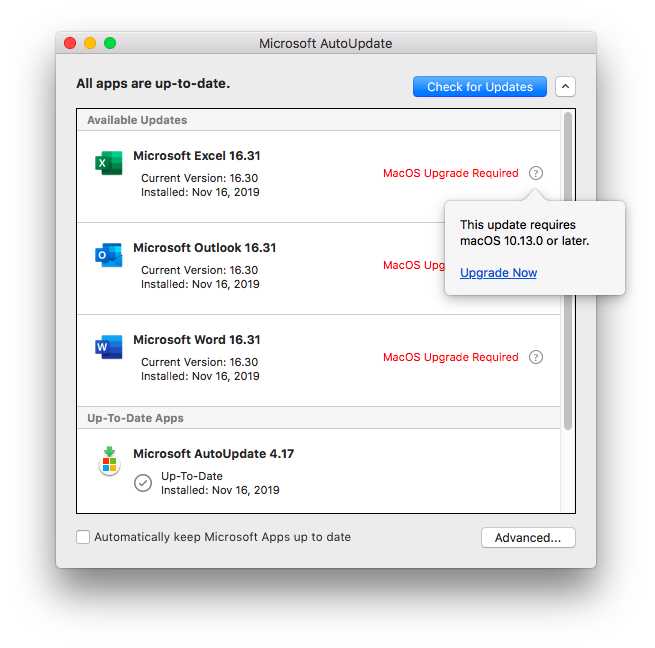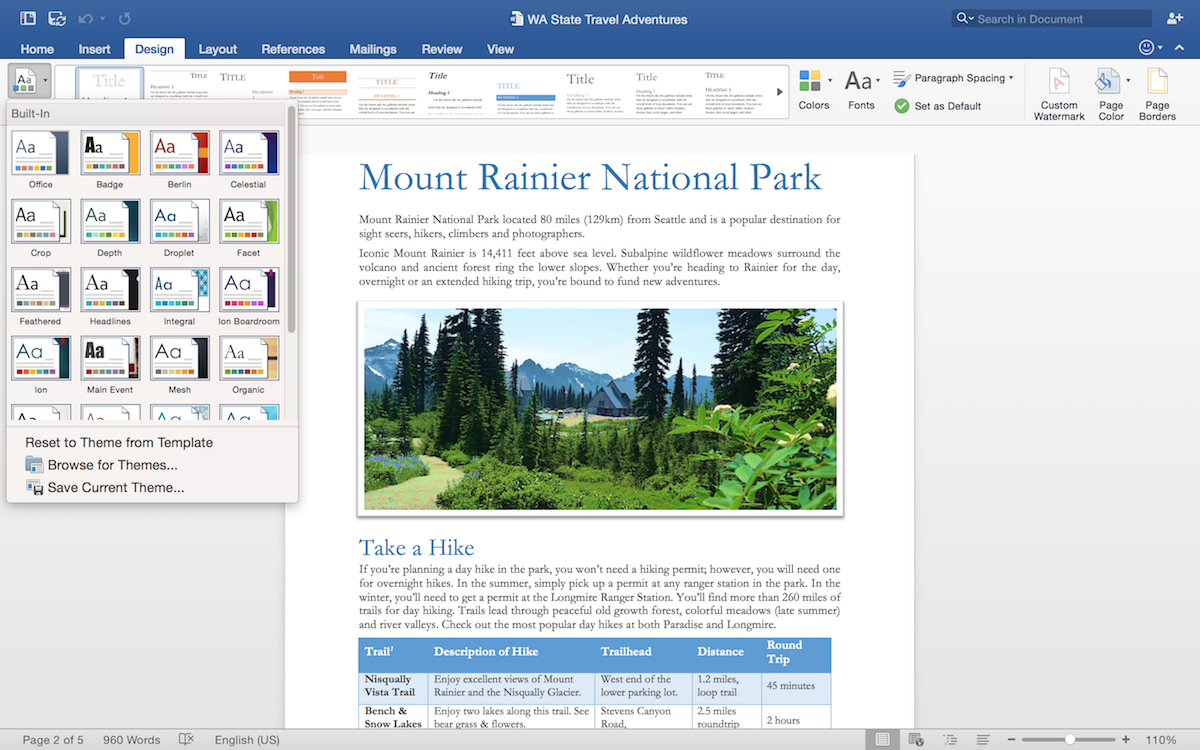
This article covers frequently asked questions about the availability of Office from the Mac App Store, and the differences between downloading Office apps directly from Microsoft.

Feb 12, 2020 What's new in Microsoft AutoUpdate Version 4.21: Note: (for Office 2019 users) If you are running macOS version older than 10.13 MS AutoUpdate will not offer you new updates, unless you upgrade your system, because newer MS Office packages require macOS 10.13+. Nothing but update errors through build 4.19 which looks completely different from previous builds (like the image above). In the past AutoUpdate had never issues updating the Office 365 apps but now after downloading the update for each apps has finished installation starts and always fails (without any explanation of course).
Starting in January 2019, the following Office applications are available for download from the Mac App Store: Word, Excel, PowerPoint, OneNote*, and OneDrive*.
* These apps were also available from the Mac App Store in previous years.
What version of Office is available from the Mac App Store?
The Office apps available from the Mac App Store provide the very latest version of Office on the Mac. Word, Excel, PowerPoint, and Outlook require an Office 365 subscription to activate. OneNote and OneDrive do not require an Office 365 subscription, but some premium features may require an Office 365 subscription.
Is this the same as Office 2019?
No. Office 2019 is the one-time purchase, non-subscription product (also known as perpetual). An Office 365 subscription provides always up-to-date versions of Office apps and access to additional premium features and services. The apps available in the Mac App Store are not compatible with Office 2019 licenses.
I currently own Office 2016 for Mac and want to upgrade my version of Office. Should I download Office from the Mac App Store?
If you own the older perpetual release of Office, you can download the new version of the apps from the Mac App Store, and purchase a new Office 365 subscription using the in-app purchase option. In-app purchase offers include Office 365 Home, and Office 365 Personal. Your license from the perpetual release of Office will not work with the app versions from the App Store. Click here to learn about Office 365 subscriptions and pricing.
I already have an Office 365 subscription, and the Office apps are already installed on my Mac. Do I need to do anything?
No. It's likely that you installed Office directly from Microsoft. The Microsoft AutoUpdate app will keep your existing apps up-to-date. The apps in the Mac App Store do not provide functionality beyond what you have today.
If I download Office from the Mac App Store, do I still use Microsoft AutoUpdate to get updates?
Microsoft AutoUpdate is only used to get updates for apps that you download directly from Microsoft. If you download Office from the Mac App Store, then the App Store will provide you with future updates of Office. You may have other Microsoft apps installed on your Mac, and AutoUpdate will continue providing updates just for those apps.
Can I have multiple versions and builds of Office installed on my Mac?
No. Office 365, Office 2019, and Office 2016 use the same application and file names. To see which version of Office you have installed on your Mac, open one of the apps, and look at the License text in the About dialog.
Can I get Office Insider builds from the Mac App Store?
No. The Office apps in the Mac App Store are production releases. Insider builds must be downloaded directly from Microsoft.
How do I cancel my Office 365 free trial that I purchased through the Mac App Store?
To cancel your Office 365 free trial that you purchased through the Mac or iOS App Store, follow the instructions on this page: View, change, or cancel your subscriptions.
Mac microsoft word updates. I exclude it from Sophos. NINicholazzZto the update / install page, i got the Excel updater (almost 946 MB). So i pop in a blank dvd, it starts to burn. Now I have to impatiently wait for this process.Burn complete, Installer fails to open updater. Upon opening it forces me to burn it to a disc.
This link redirects to the App Store, so please open this link on a Mac, iPad or iPhone.
Applies to:Office for Mac, Office 2019 for Mac, Office 2016 for Mac
Microsoft AutoUpdate (MAU) version 3.18 and later includes the msupdate command-line tool. This can be used to start the update process for Microsoft applications produced for Mac, such as Office. The tool is primarily designed for IT administrators so that they have more precise control over when updates are applied. You can download the latest version of MAU from this link.
msupdate works by sending Apple Events to the MAU daemon. On macOS 10.14 Mojave and later, you may see a privacy prompt when running msupdate for the first time. If you are using an enterprise management tool such as Jamf Pro, you should deploy a Privacy Preferences Policy Control (PPPC) payload to pre-approve access. Samples of such a payload can be downloaded from here.
Use the following steps to start using the tool:
- Open the Terminal application
- Enter
cd /Library/Application Support/Microsoft/MAU2.0/Microsoft AutoUpdate.app/Contents/MacOS - Run
./msupdate --help
The following options are displayed:
Examples of how to use msupdate
- Display the current configuration parameters for AutoUpdate:
./msupdate --config - Display the current configuration parameters in machine-readable format:
./msupdate --config --format plist - List all available updates:
./msupdate --list - Download and install all available updates:
./msupdate --install - Download and install the latest updates for Word, Excel, and PowerPoint:
./msupdate --install --apps MSWD2019 XCEL2019 PPT32019 - Download and install a version-specific update for Outlook:
./msupdate --install --apps OPIM2019 --version 16.17.180090901
Application identifiers
The following table lists the applications for Mac supported by AutoUpdate. The identifier is used when specifying the --apps parameter. When specifying multiple applications on the command-line, separate identifiers with a space.
| Application | Latest version1 | 2016 version2 |
|---|---|---|
| Word | MSWD2019 | MSWD15 |
| Excel | XCEL2019 | XCEL15 |
| PowerPoint | PPT32019 | PPT315 |
| Outlook | OPIM2019 | OPIM15 |
| OneNote | ONMC2019 | ONMC15 |
| MAU | MSau04 | MSau04 |
| OneDrive | ONDR18 | |
| Teams | TEAM01 | |
| Skype for Business | MSFB16 | |
| Remote Desktop | MSRD10 | |
| Intune Company Portal | IMCP01 | |
| Defender ATP | WDAV00 | |
| Edge Canary | EDCN01 | |
| Edge Dev | EDDV01 | |
| Edge Beta | EDBT01 | |
| Edge Stable | EDGE01 |
1 These identifiers are used for Office 2019 for Mac, either a retail or a volume licensed version, and for Office for Mac (from an Office 365 plan) running on macOS version 10.12 (Sierra) or higher.
2 These identifiers are used for Office 2016 for Mac, either a retail or a volume licensed version, and for Office for Mac (from an Office 365 plan) running on macOS version 10.11 (El Capitan) or earlier.
Microsoft office communicator for mac download. The perpetually licensed version on macOS and Windows was released on September 22, 2015.
Note
- If an update is pending for MAU itself, that update must be applied before any applications can be updated.
- Identifiers are not case-sensitive when run interactively from the command-line, but use the character casing from the table above when running from a management tool such as Jamf Pro.
Related topics
Microsoft Autoupdate For Mac Not Working
- Update history and release notes for Office for Mac